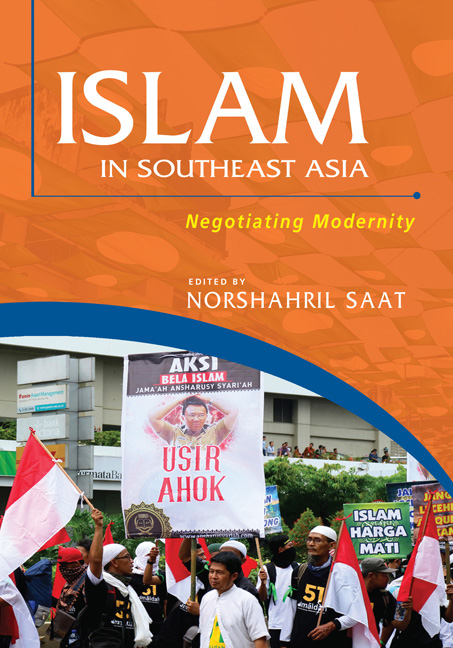Book contents
- Frontmatter
- Contents
- Preface
- About the Contributors
- 1 Introduction
- Section I Malaysia
- 2 Emergence of Progressive Islamism in Malaysia
- 3 Competing Discourses Among Malaysian Muftis: Still a Case of Arabization?
- 4 The Riyal and Ringgit of Petro-Islam: Investing Salafism in Education
- Section II Indonesia
- Section III Singapore
- Index
3 - Competing Discourses Among Malaysian Muftis: Still a Case of Arabization?
from Section I - Malaysia
Published online by Cambridge University Press: 08 June 2019
- Frontmatter
- Contents
- Preface
- About the Contributors
- 1 Introduction
- Section I Malaysia
- 2 Emergence of Progressive Islamism in Malaysia
- 3 Competing Discourses Among Malaysian Muftis: Still a Case of Arabization?
- 4 The Riyal and Ringgit of Petro-Islam: Investing Salafism in Education
- Section II Indonesia
- Section III Singapore
- Index
Summary
INTRODUCTION
Recent writings on Malaysia's religious elite show that the group as a whole is becoming more conservative, authoritarian and exclusive (Farish 2005; Norani, Zainah, and Zaitun 2005). By religious elite, I refer to Muslims who are trained in the religious sciences and they include muftis (state-appointed persons with religious authority), ulama (religious scholars), popular preachers, religious teachers and religious bureaucrats. The behaviour of the elite is necessarily a reflection of how the masses practise Islam. Of greater concern is that academics and human rights activists have associated the elite with the puritan version of “Middle East” Islam, namely Wahhabism/ Salafism (to be discussed later). For example, Marina Mahathir, a gender rights activist, opined that Malaysia is undergoing an Arabization of Islam because the way the Malays dress, behave, and think no longer reflect Malay identity. She claims that Malay women under the age of fifty no longer know how to tie the baju kurung (Malay costume). Similarly, Norani, Zainah and Zaitun make similar observations about the adoption of Islamic or Arabic-style dressing and lifestyle, which is displacing indigenous identity with that of the Arabs (Norani, Zainah, and Zaitun 2005, p. 80). Academic Syed Farid Alatas also argues that extremist ideas from the Middle East, which he refers to as Salafism, have influenced the ulama's way of thinking and behaviour. At a forum, he stated that the Malays show a lack of self-confidence in believing that they become more authentic Muslims through copying Arabs. The Sultan of Johor, Ibrahim Iskandar, also joined in to criticize the Malays for imitating the Arabs. He declared, “If there are some of you who wish to be an Arab and practise Arab culture, and do not wish to follow our Malay customs and traditions, that is up to you. I also welcome you to live in Saudi Arabia.”
To be sure, the behaviour of the religious elite, including the muftis, contradicts the way Malaysian Prime Ministers Abdullah Badawi (2003–9) and Najib Razak (2009–present) had sought to portray the country's brand of Islam: that Malaysia practises Islam Hadhari (progressive and civilizational Islam) and Islam Wasatiyyah (moderate Islam).
- Type
- Chapter
- Information
- Islam in Southeast AsiaNegotiating Modernity, pp. 35 - 62Publisher: ISEAS–Yusof Ishak InstitutePrint publication year: 2018

